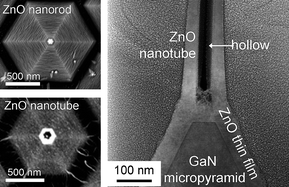Controlled epitaxial growth modes of ZnO nanostructures using different substrate crystal planes†
Abstract
A combined experimental and theoretical investigation has clarified the nanometre-scale vapour-phase epitaxial growth of ZnO ![[1 with combining macron]](https://www.rsc.org/images/entities/char_0031_0304.gif) 1), (10
1), (10![[1 with combining macron]](https://www.rsc.org/images/entities/char_0031_0304.gif) 0) and (11
0) and (11![[2 with combining macron]](https://www.rsc.org/images/entities/char_0032_0304.gif) 0).
0).

- This article is part of the themed collection: Inorganic nanotubes and nanowires

 Please wait while we load your content...
Please wait while we load your content...